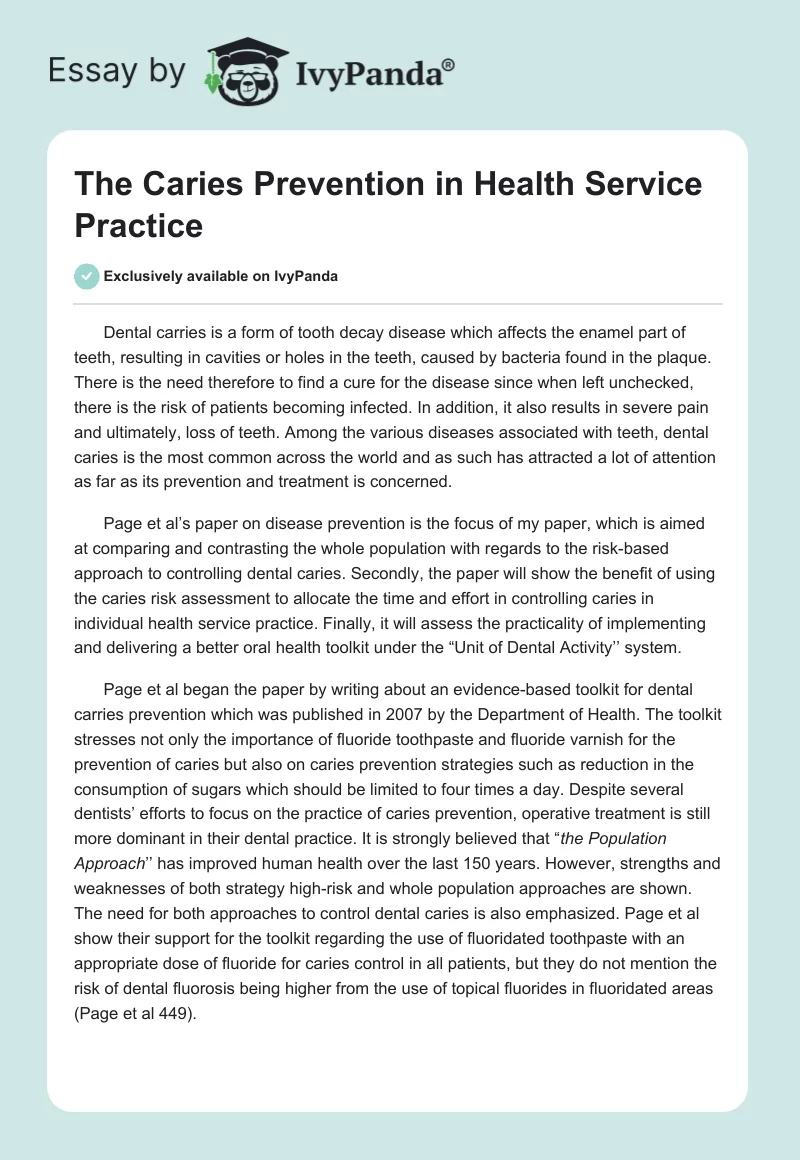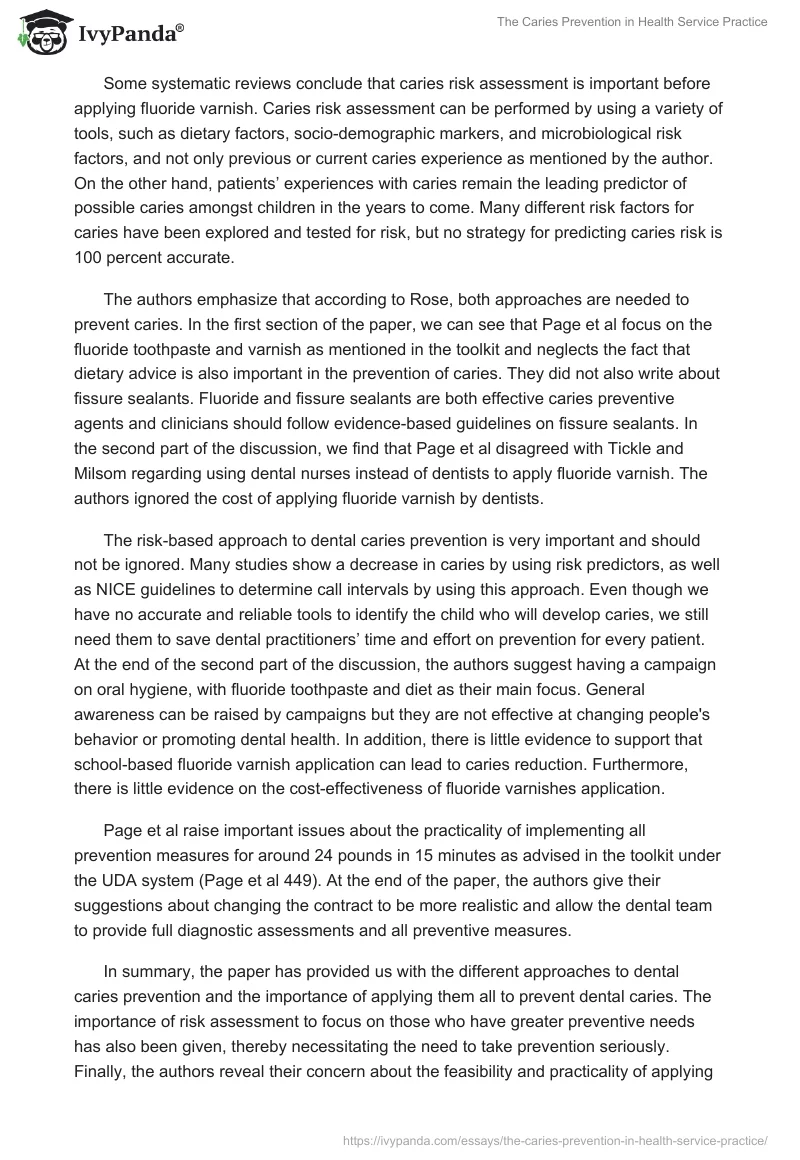Dental carries is a form of tooth decay disease which affects the enamel part of teeth, resulting in cavities or holes in the teeth, caused by bacteria found in the plaque. There is the need therefore to find a cure for the disease since when left unchecked, there is the risk of patients becoming infected. In addition, it also results in severe pain and ultimately, loss of teeth. Among the various diseases associated with teeth, dental caries is the most common across the world and as such has attracted a lot of attention as far as its prevention and treatment is concerned.
Page et al’s paper on disease prevention is the focus of my paper, which is aimed at comparing and contrasting the whole population with regards to the risk-based approach to controlling dental caries. Secondly, the paper will show the benefit of using the caries risk assessment to allocate the time and effort in controlling caries in individual health service practice. Finally, it will assess the practicality of implementing and delivering a better oral health toolkit under the “Unit of Dental Activity’’ system.
Page et al began the paper by writing about an evidence-based toolkit for dental carries prevention which was published in 2007 by the Department of Health. The toolkit stresses not only the importance of fluoride toothpaste and fluoride varnish for the prevention of caries but also on caries prevention strategies such as reduction in the consumption of sugars which should be limited to four times a day. Despite several dentists’ efforts to focus on the practice of caries prevention, operative treatment is still more dominant in their dental practice. It is strongly believed that “the Population Approach’’ has improved human health over the last 150 years. However, strengths and weaknesses of both strategy high-risk and whole population approaches are shown. The need for both approaches to control dental caries is also emphasized. Page et al show their support for the toolkit regarding the use of fluoridated toothpaste with an appropriate dose of fluoride for caries control in all patients, but they do not mention the risk of dental fluorosis being higher from the use of topical fluorides in fluoridated areas (Page et al 449).
Some systematic reviews conclude that caries risk assessment is important before applying fluoride varnish. Caries risk assessment can be performed by using a variety of tools, such as dietary factors, socio-demographic markers, and microbiological risk factors, and not only previous or current caries experience as mentioned by the author. On the other hand, patients’ experiences with caries remain the leading predictor of possible caries amongst children in the years to come. Many different risk factors for caries have been explored and tested for risk, but no strategy for predicting caries risk is 100 percent accurate.
The authors emphasize that according to Rose, both approaches are needed to prevent caries. In the first section of the paper, we can see that Page et al focus on the fluoride toothpaste and varnish as mentioned in the toolkit and neglects the fact that dietary advice is also important in the prevention of caries. They did not also write about fissure sealants. Fluoride and fissure sealants are both effective caries preventive agents and clinicians should follow evidence-based guidelines on fissure sealants. In the second part of the discussion, we find that Page et al disagreed with Tickle and Milsom regarding using dental nurses instead of dentists to apply fluoride varnish. The authors ignored the cost of applying fluoride varnish by dentists.
The risk-based approach to dental caries prevention is very important and should not be ignored. Many studies show a decrease in caries by using risk predictors, as well as NICE guidelines to determine call intervals by using this approach. Even though we have no accurate and reliable tools to identify the child who will develop caries, we still need them to save dental practitioners’ time and effort on prevention for every patient. At the end of the second part of the discussion, the authors suggest having a campaign on oral hygiene, with fluoride toothpaste and diet as their main focus. General awareness can be raised by campaigns but they are not effective at changing people’s behavior or promoting dental health. In addition, there is little evidence to support that school-based fluoride varnish application can lead to caries reduction. Furthermore, there is little evidence on the cost-effectiveness of fluoride varnishes application.
Page et al raise important issues about the practicality of implementing all prevention measures for around 24 pounds in 15 minutes as advised in the toolkit under the UDA system (Page et al 449). At the end of the paper, the authors give their suggestions about changing the contract to be more realistic and allow the dental team to provide full diagnostic assessments and all preventive measures.
In summary, the paper has provided us with the different approaches to dental caries prevention and the importance of applying them all to prevent dental caries. The importance of risk assessment to focus on those who have greater preventive needs has also been given, thereby necessitating the need to take prevention seriously. Finally, the authors reveal their concern about the feasibility and practicality of applying preventive measures under the UDA system, but on the other hand, the paper is far from being conclusive and further studies must be included. In addition, the title should reflect what is in the paper but the fact that the writers did not discuss other measures to control caries in dental practice such as fissure sealants or giving dietary advice means that there is a need for more information on the matter.
Works Cited
Page et al. “Caries Prevention in Health Service Practice”. British Dental Journal. 208. 10 (2010): 449-450.


